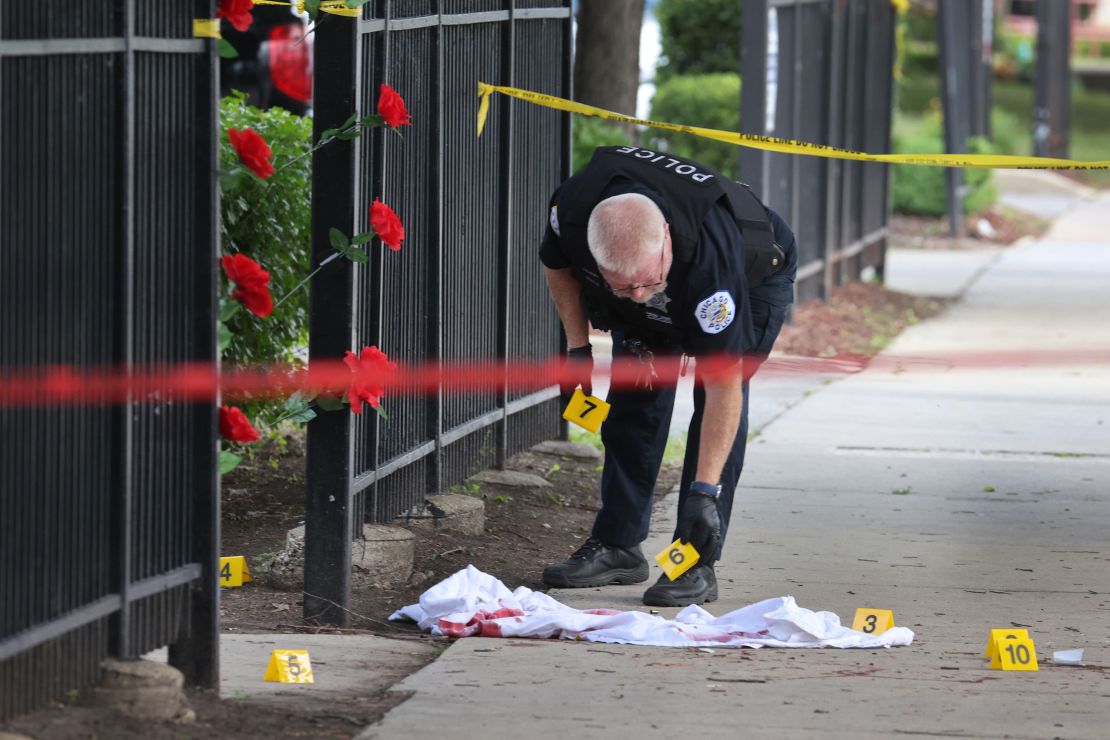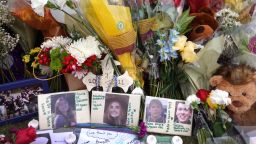One of the fastest-growing cities in the country, the capital of Texas is nearing the end of its deadliest year on record in 2021 as cities nationwide are experiencing a rise in homicides and gun violence incidents that began last year when the pandemic tightened its grip on the US.
Fueled by what both authorities and community leaders say is the easy access to guns, Austin has recorded 88 homicides so far this year, shattering the previous high of 59 in 1984.
Chris Harris, a member of the Austin Justice Coalition, a community-led organization addressing criminal justice reform as well as economic and social justice, said most of the violent incidents that occur in the city involve people “who know each other.”
“If it’s two people who know each other, clearly there is some contact that has risen to a point now that is being resolved violently instead of being resolved peacefully,” Harris said.
Austin Police Chief Joseph Chacon called the increase in violent crime “disappointing,” especially for a historically safe community.
“When you see the numbers spike like this and we’re trying to figure out exactly why that’s happening,” Chacon said, “there’s no clear-cut answer. We haven’t found that one trend that we can really pin this on.”
Austin is part of a worrying trend facing the nation. More than two-thirds of the country’s most populous cities have seen more homicides in 2021 than last year, a continuation of the troubling increase in homicides that began at the onset of the pandemic in 2020, according to a CNN analysis of over 40 major cities.
The rise in violent crime is an epidemic that is happening “all across the country,” said Thomas Abt, a senior fellow at the Council on Criminal Justice, and a result of three major factors: the impact of Covid-19 on communities and first responders, the fallout of the social unrest after the murder of George Floyd, and the surge in gun sales since the start of the pandemic.
At least nine major cities have broken their previous annual homicide records with about three weeks left to go in 2021. There have been 513 homicides this year in Philadelphia, higher than the previous total of 503 in 1990. There have been 230 homicides in Indianapolis, breaking the previous record of 215 set just last year.

These increases are not isolated to any particular region of the country. Other cities with record homicide totals include Louisville, Kentucky; Columbus, Ohio; Albuquerque, New Mexico; Tucson, Arizona; Rochester, New York; and Portland, Oregon. Milwaukee, Minneapolis and Nashville are also on pace to reach record homicide numbers by the end of the year.
Los Angeles recorded 352 homicides so far this year, and Chicago has seen 756, with year-to-date increases of 12% and 4% respectively. In Houston, homicides are up 18% from 2020.
While one-year increases don’t always portend a significant spike in crime, almost all the largest cities in the United States have seen an increase in homicides from 2019, sustaining a sharp rise that began last year.
Spike in violent crime is the result of ‘perfect storm’
According to the 2020 Uniform Crime Report from the FBI, homicides rose 30% from 2019 to 2020, the largest single-year increase the agency has recorded since it began tracking these crimes in the 1960s.
There were more than 21,500 murders last year, a total not seen since the mid 1990s. But the murder rate in 2020 was about 6.5 per 100,000 people, about 40% below what it was in the 1980s and 1990s, when homicides peaked in the United States.
“The pandemic, like community gun violence, concentrates among the poorest and most disenfranchised people,” Abt said. “So those communities are doubly impacted, not only by Covid-19, but by gun violence.”
At the same time, the institutions that are responsible for responding to violence, including police and community organizations, were also placed under stress and pressure, Abt added, referring to the phenomenon as a “perfect storm.”
Abt said the second factor is the fallout of the social unrest following the murder of Floyd by former Minneapolis police officer Derek Chauvin.
“We’re seeing police pulling back in some cities from some of their discretionary law enforcement activities and we’re also seeing communities pulling back from their ongoing collaboration and cooperation with police,” he said. “When you have that divide between cops and communities, violence tends to go up.”

The final factor experts say is causing violent crime to go up is a “huge surge in gun sales that began at the beginning of the pandemic and has not slowed down,” he said.
A small but significant number of these guns are “ending up in the wrong hands and being used in gun crimes,” Abt added.
Fayetteville, North Carolina, Police Chief Gina Hawkins said homicides in her city are “up high” right now from 23 homicides last year to 32 this year through the end of September, representing a 39% increase, according to the city’s third-quarter crime statistics.
“People are quickly pulling a gun out and without thought of repercussions and without the thought that you are truly ending a life,” Hawkins said.
Hawkins said another issue is social media “extremists” who need access to mental health resources.
“When you don’t have anyone to talk to you off a cliff or you are so geared in social media, that plays another role,” she said.
Experts have recommended looking into community-based approaches to reduce violent crime.
“Police need to be at the table and police are part of the solution, but they are not the whole solution,” Abt said. “You need community-based organizations and law enforcement agencies working together.”
Shooting incidents – both fatal and non-fatal – have increased in nearly all major US cities where data was available, according to a CNN analysis. Guns were the most used weapon in every city where information was published detailing the method of homicide.
According to the FBI report, the number of homicides last year began to escalate during the summer months, peaking in June and July and remaining at high levels after that. Capturing a full picture of homicide in the United States is nearly impossible – the UCR report is the most comprehensive data set available, but participation by law enforcement agencies is voluntary.

Last year, only 85% of the country’s more than 18,000 agencies submitted their data to the FBI. The 2021 UCR report will likely not publish until late next year.
While experts say the reasons for the rise in homicides are varied, murders are increasingly carried out by guns. The increase in gun violence was underscored in the 2020 UCR Report, which stated that about 77% of reported murders in 2020 were committed with a gun, up from 74% in 2019. There is no federal database of gun sales, but other independent surveys have found that gun sales have soared during the Covid-19 pandemic.
With just three weeks remaining in 2021, it seems almost certain that there will be more murders this year than last. However, the rate of increase in homicides does appear to be slowing.
A quarterly report published in November by the Council on Criminal Justice, which studied homicides in 22 cities during the first nine months of this year, showed the number of murders was 4% greater than the same period in 2020. In the first three quarters of 2020, the number of homicides in the same 22 cities rose by 36% over the same time frame in 2019, according to the report.
Data from consulting company AH Datalytics, which tracks year-to-date homicides across dozens of major US cities, shows a 7.5% increase in homicides so far between 2021 and 2020, down from the 10% increase observed over the summer and a further a reduction from the 30% increase observed in 2020.
A renewed focus on conflict resolution in Austin
The homicide rate in Austin peaked in 1982, and has gradually declined since then. It remained remarkably steady even as the city’s population more than doubled, hovering between three and five homicides per 100,000 people.
In the 1980s, Austin’s homicide rate stood at almost 16 per 100,000 residents, before slowly declining in the late 90s and early 2000s.This year, however, the homicide rate has jumped up to 8.5, close to the rates seen in the late 80s and early 90s.
Harris, of the Austin Justice Coalition, said the accessibility of guns in Texas and states across the country has resulted in more deadly encounters. “Maybe if we were sending other types of resources other than just police into our communities, we would be having different outcomes,” Harris told CNN.
Austin’s police department has not published how many of these homicides were committed with a gun, but according to the Gun Violence Archive, a nonprofit organization that tracks gun-related violence in the United States, there have been 82 gun deaths in the city so far this year.
Chacon said the violence is likely the result of widespread anxiety and uncertainty due to the pandemic as well as the proliferation of illegally owned weapons on the street, which makes it “a lot easier to commit very serious offenses.”
The Austin Police Department is working to combat violent crime by using its real-time crime center to connect on-duty officers with databases at police headquarters as well as the city’s new office of violence prevention.
Police officers and community advocates in Austin are putting a renewed focus on conflict resolution to combat crime.
“We really need to invest in more resources, and our organization is very much focused on trying to give more people tools and access to conflict resolution to help prevent the violence before it occurs,” Harris said.
Illegal guns pose major challenge for law enforcement
Baltimore was one of the few major cities that saw a decrease in homicides between 2019 and 2020, after a record-setting 348 in 2019. However, homicides rose from 2020 to this year, with a year-to-date total of 320 killings.
“While many of these offenders might be tied to the drug trade, the shootings and homicides are not always drug related. It’s conflict and it’s retaliation from previous conflicts and bad acts,” said Baltimore Police Commissioner Michael Harrison, who is also the president of the board of the Police Executive Research Forum.
Harrison said that chiefs across the country have been saying the “lack of consequences and the lack of fear of any consequences” in the climate as a result of the pandemic is a significant factor in the increase in violence, as well as the disruption of the criminal justice system.
“Two-thirds of the criminal justice system were not operating at full capacity like policing was and when you put that all together, here we are again seeing a rise in crime,” he said.
For 18 months, grand juries as well as state and federal trials were largely halted, Harrison said, and the system is just now “resuming deploying consequences for people who committed these bad acts.”
The city’s population has been in a steady decline for decades, down 20% from 735,632 residents in 1990. The homicide rate jumped in 2015 after two decades of steady, year-over-year reductions in murders – and has remained elevated ever since. As of November 30, there have been 921 fatal and non-fatal shootings in the city this year.
“We have a problem that is much bigger than Baltimore city,” Baltimore Mayor Brandon Scott told CNN. “We still have the historical things that are happening – the guns, the drugs, the gangs, the money, but so many more people are dying from small, interpersonal disputes.”
The Baltimore Police Department is on pace to recover as many guns as it did in 2020 with 1,302 this year after seizing 1,334 guns last year, according to Harrison.
But a new and daunting challenge is locating and seizing privately made ‘ghost guns,’ which are not branded with a serial number. Ghost guns are growing in popularity, and they are being used in more shootings and murders, Harrison said.
The department recovered only nine ghost guns in 2018 – but as of late November this year, officers recovered 294, according to Harrison.
“People can order them online in parts and some of them at home,” he said. “All you need is a credit card and enough money to buy it and its untraceable. So, it’s becoming more difficult for law enforcement to really hold people accountable for having and using these guns until the crime is committed.”
Without a serial number, it’s a major challenge for law enforcement to find the original owner or purchaser of the ghost gun that can help police trace the ballistics to other possible crimes, Harrison said.
But the department is working with its partners at the Bureau of Alcohol, Tobacco, Firearms and Explosives (ATF) and has assigned detectives to ATF to track both guns and ghost guns. The city is also the first to partner with Everytown for Gun Safety – a nonprofit focused on preventing gun violence – to launch a Gun Trafficking Intelligence Platform to track the origin of illegal guns on the street, according to Harrison.
Baltimore is launching its Group Violence Reduction Strategy in partnership with the police department and the state attorney’s office, aiming to address the root causes of violence “by focusing resources on individuals identified as being at the highest acute risk of involvement in gun violence,” according to the city’s website.
The strategy is designed to provide offenders with a pathway “away from a life of crime” and one that includes helping them with their specific needs, such as education, mental illness, crime, addiction and housing, according to Harrison.
“If they are not addressed, we may stop one thing but we’re allowing someone else to continue the cycle of violence,” Harrison said.












